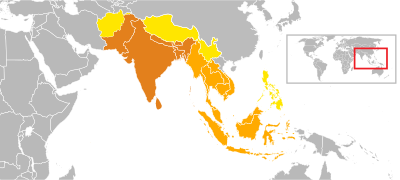THAILAND(truly) IS INDIA!!!!!! (Part ONE)
 •
by
•
by Rohan AnanthaKrishna
All contents from this are from the wiki to show that Thailand truly is India.
The wiki says:-
The term Greater India refers to the historical spread of the culture of India beyond the Indian subcontinent proper. This concerns the spread of Hinduism in Southeast Asia in particular, introduced by the Indianized kingdoms of the 5th to 15th centuries, but may also extend to the earlier spread of Buddhism from India to Central Asia and China by way of the Silk Road during the early centuries of the Common Era. To the west, Greater India overlaps with Greater Persia in the Hindu Kush and Pamir mountains. Historically, the term is also tied to the geographic uncertainties surrounding the "Indies" during the Age of Exploration.

Dark orange shows those countries which still shows our culture.
Normal orange shows countries shows those which are culturaly affected and and improved from us.
Yellow showls countries which had our cultures.
This photos shows the countries in which OUR culture is spread. This shows Thailand THAILAND!!!!!! is influenced by us.
Continued on from the wiki
In late 19th-century geography: The term "Greater India" referred to Hindustan (India proper), the Punjab, the Himalayas and extends eastwards to Indo-China (including Burma), parts of Indonesia (namely, the Sunda Islands, Borneo and Celebes), and even the Philippines."[8]
Indian cultural sphere
The meaning of "Greater India" as an Indian cultural sphere was popularized by a network of Bengali scholars in the 1920s who were all members of the Calcutta-based Greater India Society. The movement's early leaders included the historian R. C. Majumdar (1888–1980); the philologists Suniti Kumar Chatterji (1890–1977) and P.C. Bagchi (1898–1956), the historians Phanindranath Bose and Kalidas Nag (1891–1966).[13]
Some of their formulations were inspired by the then ongoing excavations in Angkor by French archaeologists and by the writings of French Indologist Sylvain Lévi. The scholars of the society postulated a benevolent ancient Indian cultural colonization of Southeast Asia, in stark contrast—in their view—to the colonialism of the early 20th century.[14][15]
“ The ancient Hindus of yore were not simply a spiritual people, always busy with mystical problems and never troubling themselves with the questions of 'this world'... India also has its Napoleons and Charlemagnes, its Bismarcks and Machiavellis. But the real charm of Indian history does not consist in these aspirants after universal power, but in its peaceful and benevolent Imperialism—a unique thing in the history of mankind. The colonizers of India did not go with sword and fire in their hands; they used... the weapons of their superior culture and religion... The Buddhist age has attracted special attention, and the French savants have taken much pains [sic] to investigate the splendid monuments of the Indian cultural empire in the Far East. ”
The term was used in historical writing in India well into the 1970s.[16]
“ "Colonial and Cultural Expansion (of Ancient India)", and written by R. C. Majumdar, concluded with: "We may conclude with a broad survey of the Indian colonies in the Far East. For nearly fifteen hundred years, and down to a period when the Hindus had lost their independence in their own home, Hindu kings were ruling over Indo-China and the numerous islands of the Indian Archipelago, from Sumatra to New Guinea. Indian religion, Indian culture, Indian laws and Indian government moulded the lives of the primitive races all over this wide region, and they imbibed a more elevated moral spirit and a higher intellectual taste through the religion, art, and literature of India. In short, the people were lifted to a higher plane of civilization." ”
The term "Greater India" as well as the notion of an explicit Hindu colonization of ancient Southeast Asia have been linked to both Indian nationalism[17] and Hindu nationalism,[18] Some scholars have seen the Hindu/Buddhist acculturation in ancient Southeast Asia as "a single cultural process in which Southeast Asia was the matrix and South Asia the mediatrix."[21] In the field of art history, especially in American writings on the Indian art history, the term survived longer due to the influence of art theorist Ananda Coomaraswamy. Coomaraswamy's view of pan-Indian art history was influenced by the "Calcutta cultural nationalists."[22]
Recently, scholars like Sheldon Pollock have written about this region by using the term "Sanskrit Cosmopolis" and argued for the millennium-long cultural exchanges, without necessarily involving migration of peoples or colonization. Pollock's 2006 book "The Language of the Gods in the World of Men" makes a case for studying this region as comparable with the Latin Europe and argues that the Sanskrit language was the unifying element of this region.
THE REST WILL COME IN PART 2 AND PART 3!!!!
And if u report this no prob i had this all saved in my files before I posted it for you bitches(thailand ppl who stil don't believe Thailand is India).
This also acts as an info to ask the PP of Yuuva(hamturk) to accept my proposal to be in the elections.


Comments
first
second!
Let the TROLLs roll......
?
wat does dat mean?
voted and subscribed
cholas ftw!
Let the TROLLs roll...... x2
hahahahaha!!!! no trolling attempts still!!!
lulwut?
okah!!!!!!
o7
Thailand is India. End of.
o7
what nothing about my sikhi